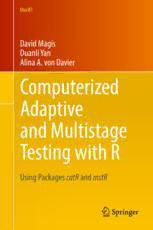Table Of ContentUseR!
David Magis
Duanli Yan
Alina A. von Davier
Computerized
Adaptive
and Multistage
Testing with R
Using Packages catR and mstR
Use R!
SeriesEditors
RobertGentleman
KurtHornik
GiovanniParmigiani
Moreinformationaboutthisseriesathttp://www.springer.com/series/6991
David Magis • Duanli Yan (cid:129) Alina A. von Davier
Computerized Adaptive and
Multistage Testing with R
Using Packages catR and mstR
123
DavidMagis DuanliYan
DepartmentofEducation EducationalTestingService
UniversityofLiege Princeton,NJ,USA
Liege,Belgium
AlinaA.vonDavier
ACTNextbyACT
IowaCity,IA,USA
ISSN2197-5736 ISSN2197-5744 (electronic)
UseR!
ISBN978-3-319-69217-3 ISBN978-3-319-69218-0 (eBook)
https://doi.org/10.1007/978-3-319-69218-0
LibraryofCongressControlNumber:2017956343
©SpringerInternationalPublishingAG2017
Thisworkissubjecttocopyright.AllrightsarereservedbythePublisher,whetherthewholeorpartof
thematerialisconcerned,specificallytherightsoftranslation,reprinting,reuseofillustrations,recitation,
broadcasting,reproductiononmicrofilmsorinanyotherphysicalway,andtransmissionorinformation
storageandretrieval,electronicadaptation,computersoftware,orbysimilarordissimilarmethodology
nowknownorhereafterdeveloped.
Theuseofgeneraldescriptivenames,registerednames,trademarks,servicemarks,etc.inthispublication
doesnotimply,evenintheabsenceofaspecificstatement,thatsuchnamesareexemptfromtherelevant
protectivelawsandregulationsandthereforefreeforgeneraluse.
Thepublisher,theauthorsandtheeditorsaresafetoassumethattheadviceandinformationinthisbook
arebelievedtobetrueandaccurateatthedateofpublication.Neitherthepublishernortheauthorsor
theeditorsgiveawarranty,expressorimplied,withrespecttothematerialcontainedhereinorforany
errorsoromissionsthatmayhavebeenmade.Thepublisherremainsneutralwithregardtojurisdictional
claimsinpublishedmapsandinstitutionalaffiliations.
Printedonacid-freepaper
ThisSpringerimprintispublishedbySpringerNature
TheregisteredcompanyisSpringerInternationalPublishingAG
Theregisteredcompanyaddressis:Gewerbestrasse11,6330Cham,Switzerland
ToMaxime,Éléonore,andAnaëlle,
probablyfutureRusers
DavidMagis
TomydaughterVictoriaSong,anavid
Rprogrammer
DuanliYan
Tomyson,Thomas,whosetimehascome
tolearnR
AlinaA.vonDavier
Foreword
Adaptive testing is, by now, a well-established procedure in educational and psy-
chologicalassessment.EarlyadoptersintheeducationalfieldintheUSAwerethe
licensingexam(NCLEX/CAT)oftheNationalCouncilofStateBoardsofNursing
and the Graduate Record Examination (GRE). But at the time of this writing, the
trendofusingadaptivetestingisworldwide.Forinstance,intheNetherlands,sev-
eraladaptivetestsareavailableforthecompulsorynationwidefinalassessmentsin
primaryeducation.Further,alsolarge-scaleinternationaleducationalsurveyshave
implemented adaptive assessments; the Organisation for Economic Co-operation
and Development (OECD) Program for International Student Assessment (PISA)
andProgramfortheInternationalAssessmentforAdultCompetencies(PIAAC)are
prominent examples. Adaptive testing has also reached fields beyond educational
assessment, such as epidemiology (the Patient-Reported Outcomes Measurement
Information System (PROMIS) project for health assessment is an example), and
organizationalassessment(forsupportingselectionandpromotiondecisions).Most
of these applications are based on adaptive selection of individual items. A more
recent development is towards adaptive selection of testlets. This development is
mainly motivated by the ease with which content control can be supported and
generallygoesunderthenameofmultistagetesting.
Givenitswidespreaduse,itmaycomeasnosurprisethatgoodintroductionsto
adaptive testingareavailable.Imentiontwoeditedvolumes:ComputerizedAdap-
tiveTesting:APrimereditedbyHowardWainer,whichgivesanexcellentrelatively
nontechnicalintroductiontothekeyingredientsandpracticalimplementationissues
ofadaptivetesting,andElementsofAdaptiveTestingeditedbyvanderLindenand
Glas, which delves a bit deeper into the statistical issues involved. An excellent
introductiontomultistagetestingcanbefoundinComputerizedMultistageTesting:
TheoryandApplicationseditedbyYan,vonDavier,andLewis.
So where is the present volume and the software that goes with it to be
positioned? First of all, the book provides a general overview of the statistical
technologyunderlyingadaptivetesting,togetherwithRpackagesthatcanprovide
illustrations for the theory. But there is more. When developing an adaptive
vii
viii Foreword
test, many questions must be answered and many decisions must be made. For
instance, is my item bank big enough given the foreseen number of respondents
and lifespan of the test, is the test length appropriate for the targeted reliability,
and are the item parameters adequate for the targeted population, to mention a
few questions. The website of the International Association for Computerized
Adaptive Testing (IACAT) adds some more issues: content balancing (to create
a test where the content matter is appropriately balanced), item exposure control
(to prevent compromising of the test), combining multiple scales, and proctoring
of administration via the Internet. To complicate things, all these aspects usually
interact. The simulation studies such as those supported by the R packages can
help answering such questions and support the decisions. The choice of R is a
good one, motivated by the fact that it has become the most versatile and flexible
open-source platform for statistical analyses and creation of graphical output.
For most developers and users of statistical tools, R has become the standard of
industry. It offers practitioners the opportunity to add their own functionality to
existingapplicationsandprovidesacommongroundforexchangingtheirsoftware.
Therefore, I am sure that this book and the simulation software accompanying it
willbeextremelyhelpfulfordesigningadaptivetests.
ProfessorofSocialScienceResearchMethodology CeesGlas
UniversityofTwente,TheNetherlands
Acknowledgments
Thisbooktakesitsoriginfromaninspiringdiscussionbetweentheauthorsduring
the meeting of the International Association for Computerized Adaptive Testing
(IACAT)inCambridge(UK),October2015.Fromthisearlyproject,severaldrafts
werewritten,re-organized,reviewed,andupdatedtoendupwiththecurrentversion
ofthebook.
Theauthorswishtoexpresstheirsincereacknowledgmentstothemanypeople
who took some of their precious time to read the provisional chapters and make
insightfulcomments:HongJiao(UniversityofMaryland),KimFryer,LixiongGu,
Sooyeon Kim, Yanming Jiang, Longjuan Liang, Guangming Ling, Yuming Liu,
Manfred Steffen, Fred Robin, Jonathan Weeks, Meng Wu (Educational Testing
Service).TheauthorswanttoexpresstheirgratitudetoCeesGlaswhoacceptedto
preface this book long before it came out in its final version. Eventually, special
thanks to Jim Carlson from Educational Testing Service for his comments and
suggestions throughout the whole book, and to Andrew Cantine (technical editor,
ACTNext)forcarefullyeditingthewritingofthisbook.
ix
Contents
1 OverviewofAdaptiveTesting .............................................. 1
1.1 LinearTest,CATandMST............................................. 1
1.1.1 LinearTest ...................................................... 1
1.1.2 CAT.............................................................. 2
1.1.3 MST............................................................. 3
1.2 OrganizationofThisBook ............................................. 3
2 AnOverviewofItemResponseTheory ................................... 7
2.1 PrinciplesandAssumptionsofItemResponseTheory ............... 7
2.2 CommonlyUsedIRTModels .......................................... 9
2.2.1 UnidimensionalDichotomousIRTModels.................... 9
2.2.2 UnidimensionalPolytomousIRTModels ..................... 12
2.2.3 MultidimensionalIRTModels................................. 17
2.2.4 OtherIRTModels............................................... 19
2.3 ParameterEstimation ................................................... 20
2.3.1 ModelCalibration .............................................. 21
2.3.2 AbilityEstimation .............................................. 22
2.3.3 InformationandPrecision...................................... 25
2.4 FurtherTopics........................................................... 27
2.4.1 Dimensionality.................................................. 27
2.4.2 LocalItemIndependence....................................... 28
2.4.3 ModelandPersonFit........................................... 28
2.4.4 DifferentialItemFunctioning.................................. 29
2.4.5 IRTLinkingandEquating...................................... 29
PartI Item-LevelComputerizedAdaptiveTesting
3 AnOverviewofComputerizedAdaptiveTesting......................... 35
3.1 IntroductionandBackground........................................... 35
3.2 CATBasics.............................................................. 36
xi

